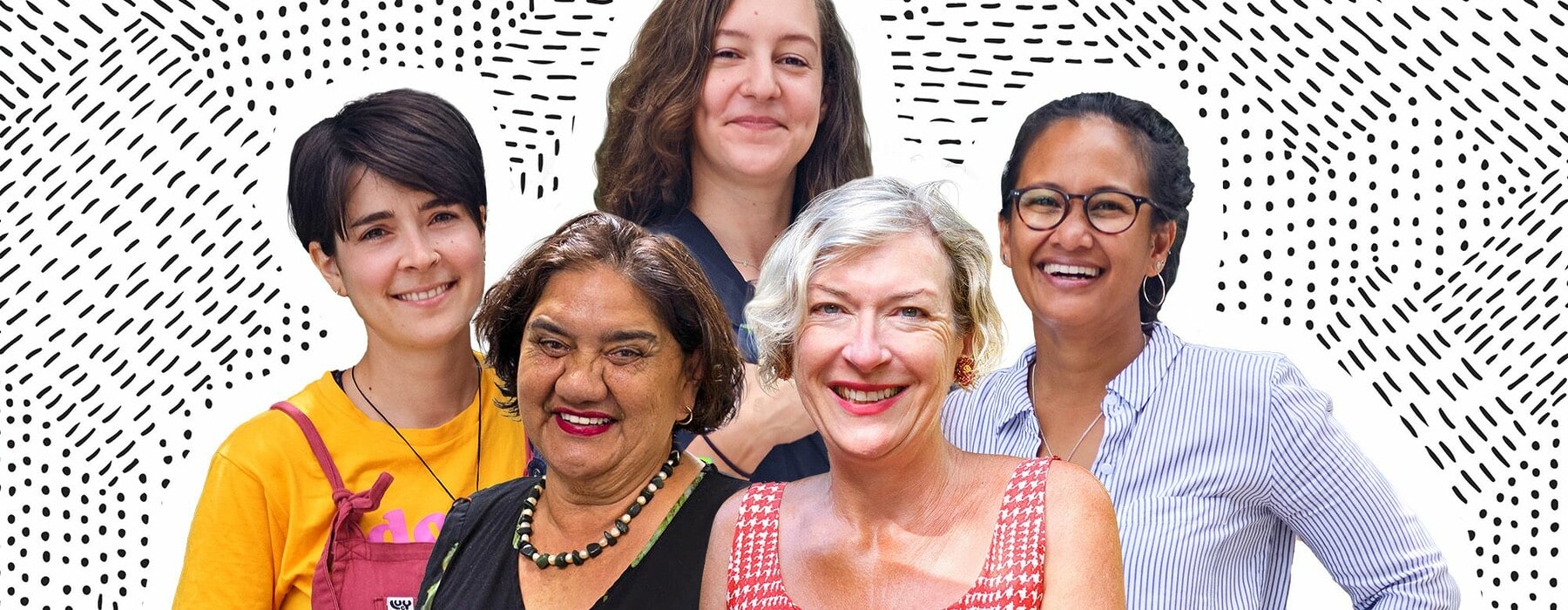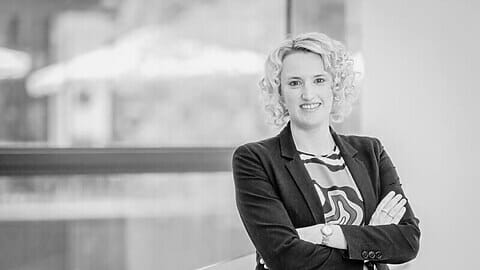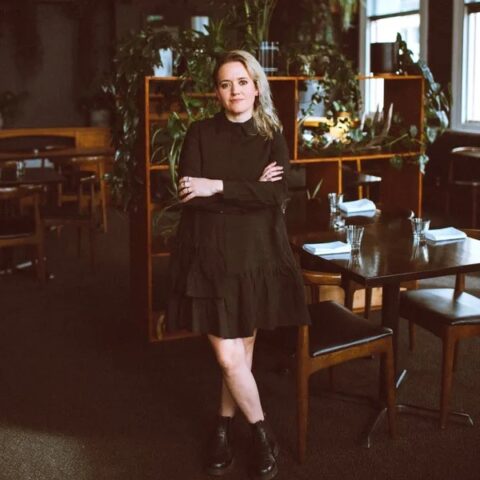Josie McNaught speaks to five women about what it’s like to switch careers and follow your dream – just like she did.
It starts as a niggle in the back of your mind, on the days when you feel like your job and your life are a bit ho-hum. You wonder what it would be like to make a change, listen to your heart instead of your head and follow your dream.
I can hear you scoffing. And you’re right – fantasy Hollywood musical it is not. Speaking from experience, you don’t wake up one day and decide to change careers. Like so many things in life, it’s something that creeps up on you month by month, or year by year. Maybe it will happen after a difficult time at your current job, a redundancy, a financial windfall, becoming a parent, or going through a break-up.
It’s the realisation that there is something else out there and it’s time you went after your dream, even if you fail. It’s the day you finally accept that if you don’t change something you’ll regret it for the rest of your life. It’s the day you stop and look around and think…Is this all there is?
For newly minted lawyer Emma Moss, budding cabinet/furniture maker Mathilde Polmard, apprentice cabinet-maker Myla Gabagat, carpentry apprentice Marie Beringer, academic Ella Henry, and me – a former arts journalist turned arts lawyer – the decision to change career is one of the best we have ever made, as well as one of the hardest.
Forget online self-improvement courses promising a few short weeks to “change your life” . In the case of completing an apprenticeship, degree or PhD, it is years of commitment. Blood, sweat and tears doesn’t cover the half of it.
Making a move
Successful HR consultant Emma Moss, 43, wanted to study law after high school – but her final marks weren’t high enough to get into law in Australia back then.
“So I did psychology but I always had this unfulfilled hope that one day I would do law.” In the end Emma’s husband threw down a challenge: “He said, ‘If you are going to do it, do it! And if not, stop moaning about it!’”
Dr Ella Henry (Ngātikahu ki Whangaroa, Ngāti Kuri, Te Rārawa), Associate Professor of International Business, Strategy and Entrepreneurship at AUT, found herself studying years after an ignominious end to her schooling at age 15, followed by lots of roaming, partying, and “living a hell of a life – but there was no grand plan to get a PhD”.
The now 67-year-old remembers her early days at Auckland University: “Back in 1986 the only time I could get childcare was at 4pm on a Monday, so I ended up studying sociology.”
That lack of childcare led to an early involvement in student politics though.
“I got together with a bunch of parents, and we occupied the [university] registry building demanding better creche facilities on campus. There’s nothing like changing nappies in front of old white men – the sight of poo was enough to get us a new creche in 1988,” she says with a wicked laugh.
For Mathilde Polmard, 31, the road to being a “maker” was more orthodox.
“I studied Spatial Design at Massey University in Wellington, which had a great conceptual and practical approach to creating spaces. I really loved it but after five-plus years working in the design and architecture industry – where making doesn’t have much of a place – I realised I missed not knowing how things were made.”
Mathilde says she felt she didn’t know enough about the materials she was specifying in her designs.
“I had no idea how some materials actually performed and felt at a larger scale – or how cabinetry and framing were actually put together.”
She says it didn’t feel right turning up on site with tradies who knew how to make everything.
“I was the one making the decisions yet I had theoretical knowledge but not nearly enough practical knowledge for my liking. That’s when I realised I was a maker as well as a designer and I needed to balance things out by using my hands more.”
She set out to learn furniture-making by interning for designer David Trubridge in the Hawkes Bay and more recently after meeting like-minded Myla and Marie started working for tiny house fit-out company Variant Spaces in Auckland a few days a week.
She supplements making furniture with freelance design projects. It’s a juggle but she wouldn’t have it any other way. More recently she started getting projects that combine both design and making skills.
“It’s been nice coming full circle, being able to relate making and designing skills to one another.
“Builders will tell you there is always a way. In design you sometimes get stuck in limbo because there are so many uncertainties, and you can’t solve them all on the drawing board.”
For carpentry apprentice Marie Beringer, 31, it was love at first sight – love for Nouvelle Zélande that is.
“I loved it so much, it felt like home when I landed. I fell in love with the country and its people.”
Marie first came to New Zealand on a university internship doing wastewater treatment research at NIWA in Hamilton.
Wanting to finish her bachelor’s degree in environmental science, she went home to Alsace–Lorraine, in eastern France, all the while hoping to come back to New Zealand where she had felt so at home.
She did, and got a job with Watercare in Auckland for about three years. But it wasn’t her passion.
Inspired by a video she had watched several years earlier about a Kiwi guy who had decided to build his own tiny house from scratch, Marie did a workshop to learn the basics and then ordered her trailer. (To qualify as a tiny house, it has to be built on a trailer because you have to be able to shift it.)
Although she had no building experience, she went on to design and build her own tiny house on wheels in Taupaki, West Auckland.
“I thought, ‘How crazy is that?’ In New Zealand someone decides to build a house and then they just do it. It made me realise that here, you can start anything, work hard at it, and, hopefully, achieve it. In France, it’s not that easy. If you don’t have a degree in something, you can’t do it. Having the certificates is the only entry point.
“It took a year and half to build from start to finish. After that there was no going back to the lab at Watercare. I realised I loved building too much.”
Fast-forwarding a few years, she met Myla and Mathilde, and she is now doing an apprenticeship through the Manukau Institute of Technology with Shaye’s Tiny Homes in the Auckland suburb of Henderson.
Marie, who now lives in the northern fringe of Auckland in the tiny home she built herself, says: “My dream is to be fully self-sufficient one day – which will hopefully happen if I don’t kill my first tomato plant this year.”
Myla Gabagat, 40, had a more windy path. She grew up in Ruakaka and – unlike her twin sister, who is a lawyer – struggled in the traditional classroom setting.
“My teachers didn’t realise I was dyslexic. I struggled for a long time with academics, but I was always happy as a creative student in woodwork classes.”
Myla says she could read the words but couldn’t understand what she was reading and that made it hard to focus in class.
“Later on they let me focus on woodwork instead of English, but still it wasn’t given to me as a career opportunity. Building and cabinetry were still perceived as masculine jobs and not offered to women.”
Instead Myla went through a variety of jobs in New Zealand and overseas: studying photography in Invercargill, working in tourism in Auckland, playing numerous Disney characters in Orlando, Florida, and working on super-yachts for over eight years as a chef’s assistant, stewardess, and deckhand.
“But I was tired of living out of a suitcase so I came home and, even though I knew I still
loved woodwork, I could hear this voice inside me saying: ‘Do what you want, do what makes you happy.’
“It still didn’t feel like the making industry was welcoming to me. So I did a Diploma in Web & UX Design instead.” (User Experience Design is the process designers use to build products that provide satisfying experiences to their users.)
The challenges
The road can be just as difficult at times for women who swap one desk for another as it is for those making more visibly dramatic moves – as I know from personal experience. I can still clearly remember being asked in 2013 to meet with an academic advisor at Auckland University’s law school before I enrolled. He questioned my desire to start a “full law degree” at age 48 and suggested an “easier” qualification as a legal executive.
I later found out I was not the only mature woman student to receive this little homily, but it made me more determined than ever to do law. I was warned that my first degree, a middling BA from the 1980s, would probably not provide the requisite GPA score for entry to second-year law. But when I finished in the top five students for the two first-year law papers, which I sat concurrently, scoring an A and A+ no less, I thought I was a shoo-in for the second year.
Instead, I met with the first of many obstacles to pursuing my dream. The law faculty grudgingly admitted that, although I demonstrated “legal aptitude”, my academic ability, based on my 1980s grades, was in doubt and I would therefore have to complete another year of “non-law papers” to prove I was worthy of a place in the second-year courses. Despite protestations to the highest levels in the university, the door was firmly closed.
Luckily for me, Auckland has two law schools and I skipped up the road to the relatively new law faculty at Auckland University of Technology (AUT), where I was welcomed with open arms. By cross-crediting some papers from my BA, and enrolling in summer school, I completed the four-year degree in just three years– including several A passes, a prize for top mark in one of my papers, and I made the Dean’s list for academic achievement. Yes, the irony of that wasn’t lost on me either.
Emma Moss also flirted with doing her degree at Auckland, but for different reasons also ended up at AUT.
“Auckland wouldn’t let me do law part-time and I met [similar] resistance from them back in 2012/2013.” She did not know AUT had a law programme until a friend enrolled in 2017.
“I had a look and there was a lot of noise about lecturers coming across to AUT from Auckland Uni. My first lecturer at AUT had blue hair and pink tights and I thought, ‘This is cool!’
“The lecturers also seemed so invested in sharing what they knew, and the same with my fellow students. At Auckland I felt there was this young, white, middle-class, privileged male vibe in the law school and that didn’t suit me at all. From day one at AUT, I absolutely loved it.”
Throughout her studies Emma juggled HR contract work with caring for her then three-year-old son, Ethan. She admits it was an incredibly busy time, but she got top marks and finished with honours.
She was admitted to the bar in August 2021 and snapped up by one of the country’s top employment and public law firms, Chen Palmer.
The challenges were different but similar for Mathilde, Marie and Myla, who were dealing with the world of male tradies. What really helped them is that all three switched careers at similar times and could support each other – even working for the same businesses at times.
Mathilde started working for tiny house cabinetry company Variant Spaces, and soon after Myla and Marie helped out at VS when work was available.
Marie then started working for tiny house builder Shaye’s Tiny Homes that the cabinets were being built for and stayed there to do her carpentry apprenticeship.
Mathilde saw a job ad for a woodworker at a company down the road from her current job and sent it to Myla to apply.
A month later Myla was working at Fieldcraft, in Auckland’s Kumeū, as a cabinetry apprentice alongside doing project management for them. Mathilde now sometimes works there also when needed. This would have never happened without the help of one another.
“We encouraged each other to take the leap and join the world of trades! We were able to chat through the ups and downs of it all… we were doing it together.”
By some very lucky star alignment, they met at a time in their thirties when all three of them were ready to do more making: Marie had just spent a year building her own tiny house and had a great workshop for them to make in; Myla was making clocks and furniture from unwanted pallets from her home workshop; and Mathilde had recently made storage furniture for a local cafe.
“I finally felt that I had found my tribe – woodworking women,” says Marie.
What started with weekend sessions making in Marie’s workshop (under the name “Triple M.akers”) and dreaming of making their hobby more of a reality, somehow led to the three of them now professionally working in the trades just 18 months later.
Their bonds were strengthened by the fact that Marie and Mathilde both came from Alsace–Lorraine while Myla had also lived in France for six years while yachting. Marie and Mathilde found France’s academic education system restricting and felt that New Zealand opened up many more possibilities to learn new things and be whoever you wanted to be.
Once, Mathilde’s work needed a hand for a big fit-out and she knew Marie was available at the time.
“Just like that, I started making furniture. It would never happen like that in France,” says Marie.
All the women say the “blokey side” of the building trade hasn’t been the problem that many women might expect.
“Fieldcraft has a great company culture and working environment that I’ve felt really comfortable learning in. It’s six blokes and me but I never feel that gender is an issue,” says Myla. “But when we go on site, it’s all guys and they do behave differently – but they will lend you equipment and share their knowledge.”
Mathilde: “If there is too much ball-shuffling and burping I let them know. But compared to the experience of my male friend in France, where the sexual jokes went on all day long, there is none of that here. Fart jokes are about it.”
Marie says it can be challenging sometimes fitting into a male-dominated workplace. But having grown up with three older brothers it feels familiar.
“I work with five builders who are caring, patient and always keen to share their knowledge as I’m learning,” she says. “It’s also a perk at times being a woman on site. It seems we might get more sympathy than perhaps a male apprentice would when we forget our tools or make mistakes.
“You feel strong and powerful at the end of the working day. You have used that drill and that drop saw. Women are so apologetic about everything, but when you use your strength, it gives you confidence. I wish more women would have it.”
Stamina on site is something all the members of Triple M.akers are aware of.
Myla is diminutive and admits that being petite means it sometimes takes her a little longer to do things. She says Phil Badger, her boss at Fieldcraft, had never had a female apprentice before.
But she has not encountered the same gender discrimination in building as in her days on yachts.
“I’ve worked in those masculine-dominated industries. I have been through it all and heard it all – ‘Women shouldn’t be doing this type of work etc.’ I just choose to ignore those comments.”
Safety first is their mantra and basic stuff like eating well and getting enough sleep. So instead of energy drinks and pies, they will snack on muesli bars and bananas. Mathilde says women are just as capable as men physically, we just approach it in a different way.
“My circus pole dancing has given me upper-body strength and I use that and technique to carry, for example, sheets of wood. We practise yoga and we keep our backs straight. We don’t rely on brute strength alone.”
It sounds exhausting – and it is. Myla has just pulled a 6.45am to 8.45pm shift the day before on Waiheke Island, working with Mathilde, installing a new brewery.
“I love being on my feet,” says Mathilde. “It suits my temperament. But it’s such good exhaustion! You find this new rhythm in using your body and – get this! – you do your step challenge without even trying. When I get home, I have horizontal time to recover, but I don’t need to exercise. My calorie count is done.”
Rewards and trade-offs
For us desk-dwellers, the risks, challenges and rewards are “same, same but different” as the saying goes.
Ella started her degree in 1986 with a baby on her hip. She well remembers walking into that lecture theatre as a mature, Māori woman who had been kicked out of the education system at 15.
“I kept expecting someone to tap me on the shoulder and say, ‘F-off! You’re a fraud!’ There were all these bright young things, but after a couple of years I realised I was smarter than a lot of them. I had a lot more life experience too. This was a revelation as I had never framed myself as being intelligent. It’s a dangerous drug to be exposed to in your thirties!”
Emma says she and her husband weighed up the risks before she enrolled. “I had a well-paid job I was about to give up for four to five years, plus there was childcare and uni fees to pay. Add in all the money you aren’t earning over that time and it looks like a $1 million gamble.”
There’s also the “Mum guilt” which Emma, Ella and I all felt acutely. I know the sheer number of evenings I spent hunched over my books, especially in second year, impressing and horrifying my children in equal measure. And running the house and family – even with a supportive partner – was a real challenge at times.
Mathilde says if you get too comfortable in your job, you don’t get challenged, but she doesn’t see her move from design to making as ditching one set of skills for another. One of the silver linings of changing careers is that you always have those earlier qualifications up your sleeve and can combine them.
“It’s not like you cancel these skills out. During lockdown I couldn’t be in the workshop making things so I got back to the drawing board and got some design projects going.”
Diversifying her skill set has also worked for Emma. While she uses much of her employment/HR experience in her law work, she always has her original career skills to draw on if she ever needed to move back into HR.
Myla continues to project-manage website builds while completing her apprenticeship part-time and says she is lucky both roles provide a flexible working environment.
For Ella, it’s the teaching aspect of her career which resonates and provides her with the most pleasure, rather than the hard academic graft of researching and publishing and delivering papers at conferences, albeit online these days.
“Who knew that was the most radical thing I could do? Teaching those minds and introducing them to other ways of seeing and thinking about the world.” She says her students are true global citizens who are acutely aware of the planet and the environment.
“At their age all I wanted to do was drink and do drugs and party. I hate people in my age group bagging young folk as though we never made any bad choices. I am so lucky to be exposed to these beautiful young minds.”
Ella says her early life was quite troubled given she had a destructive lifestyle and grew up in a time when it was not cool to be Māori, let alone a Māori woman.
“I lived in a small, isolated community and then we moved to Auckland. The discrimination and negative energy impacted on me for a big chunk of my life. But in retrospect, my decision to work on the ocean delivering super-yachts and on a prawn trawler saved me.
“Being on the sea you are one with your environment, you are alert and aware. I was saved by being at sea.”
She says that time healed her and helped her connect with her identity as Māori. “Colonisation had taken the ocean out of my gene pool,” she says.
As a consequence, the woman who signed up for that sociology paper over 35 years ago is a lot more grounded and focused than her perpetual partying 21-year-old self.
In many ways, all the women in this story have been saved too by taking that leap of faith and changing direction. My career as an arts journalist was stagnant as the internet ate into traditional areas of revenue and the ease of self-publishing and sharing of content (for free) challenged my ability to make a satisfactory living.
Marie loves building and getting all the skills she needs but her bigger dream is to build a sanctuary for all women.
“I would love for six months of the year to provide a safe place in some funky houses, like a tree house, on a property, and teach other women to build. I want to make sure that everyone who has the desire to build can access the skills and I’m very excited about having more women in the industry.”
Mathilde says meeting the other two “M”s has really transformed her new career. In any given week she can work with both Myla and Marie, whether it’s a tiny house fit-out or a commercial job. “As a result of our connection one of these two is always there now when I turn up on site. I get to work with my mates… How did that happen?”
Myla says she wants to expand her own business, Mylamade, which rebuilds/recycles timber and pallets into all manner of furniture and objects. For now she wants to focus and finish her apprenticeship, and keep listening to her gut.
“It’s the small voice inside, listen to it. But also ask for advice, do your research. If it’s something you really want to do you’ll find your way there.”
Emma too has big plans and does not see her later start in law as a barrier to getting to the top of her new profession.
“I think age and maturity and having had a career already, you can do whatever you want to do. I want to change the world and the system, and to do that you have to be in the system to have a view on how it’s being run. In terms of law, I’m not too old to change the world and the system. I can be that person.”
For me, the change from journalism to law has been liberating. I love the law – it’s intellectually stimulating, and I still get to work with people in the creative sector and advocate for them, arguably more effectively than when I was a journalist. In my new role I can go beyond a news story and resolve an injustice, rather than just exposing it.
None of us set out on the paths we have followed knowing where they would lead. And perhaps that lack of overall planning is the secret to making the change.
“I have always lived my life in a very unplanned and chaotic way, if that makes sense,” muses Ella. “Now that I’m getting older, I can reflect on the times in my life where I’ve made choices which in retrospect could have set me on a completely different course. I didn’t realise I had a career until I was 50. I just kept taking jobs when they came up and then I realised I had a profession.”
Her current role as one of our leading academics is a far cry from her activist role, walking up Queen St with a megaphone.
For Marie the swap from lab to lathe was fuelled by her knowledge that if she didn’t do it, she would regret it.
“And I was so confident that it couldn’t be worse than my other job. I wasn’t scared – it was something I wanted so badly to do. And now I’m doing it.”








